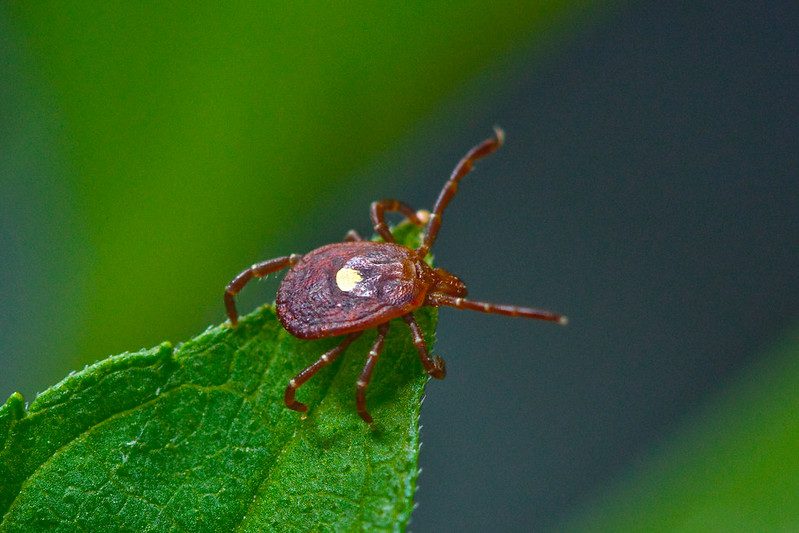A roast beef sandwich sent Katie Voelker to the hospital in June 2022.
Six hours after dinner, she woke in the middle of the night with hives, an itchy throat, nausea and dizziness.
“I had no idea what was happening to me,” the Lincoln resident said. “So I had my husband rush me to the hospital, worried my throat was going to close up.”
Voelker’s mind raced, eventually arriving at a memory of an incident from a month earlier while turkey hunting at nearby Pawnee State Recreation Area. She had been bitten by a tick, but it didn’t look like Nebraska’s most common blood-feeding arthropod, the American dog tick. Instead of a splotchy white band on its back, it had a single white dot.
Voelker identified it as a lone star tick, a carrier of a syndrome that can cause an allergy to red meat.
“I mentioned the lone star bite to a hunting buddy and joked about how ironic it would be if I, a hunting enthusiast, ended up with a meat allergy …” Voelker said.
She didn’t give the bite another thought – until the sandwich incident a month later.
Until this summer, alpha-gal syndrome (AGS) was a relatively obscure disease known by scientists, researchers and a few doctors.
Then in late July, the Centers for Disease Control and Prevention (CDC) announced that a five-year study determined up to 450,000 Americans may have been affected by AGS since 2010 – nearly the combined populations of Lincoln, Columbus, Kearney and Grand Island.
If testing trends continue alongside the geographic expansion of the lone star tick, researchers wrote, the number of AGS cases in the U.S. will increase.
The syndrome causes a hypersensitivity to a sugar molecule found in most mammals outside primates. Those affected must avoid beef, pork, lamb, venison, rabbit – basically any meat from a mammal.
Experiences vary. Some people’s reactions may be mild and others’ life-threatening. There is no cure, but mild reactions can be treated with antihistamines.
“The first few months were the hardest,” said Voelker, who confirmed her infection with a blood test. “My sensitivity was highest at that point, and I not only had to cut out all red meat, but dairy and other foods with mammal-derived ingredients as well.”
Central to this emerging illness is one of nature’s most persistent pests. When ticks hop aboard a new host, they find a patch of skin – often behind the knees, the head or ankles – and cut into it with hooks that are just one part of a mouth adapted to parasitic life.
Their saliva can have anesthetic properties, preventing hosts from realizing they’ve been bitten.
It’s also the vessel for disease, said Jody Green, an educator with Nebraska Extension. And it’s getting more difficult to avoid tick spit when spending time outdoors.
“Nowadays, everywhere you go that’s fun is a tick-infested habitat,” Green said.

Lone star ticks appear to be on the move. The arachnid’s historic range went as far north as extreme southern Iowa and as east as New Jersey.
In recent years, though, the tick has migrated to southeast Nebraska.
Research on the lone star tick and others has led some scientists to believe climate change is among the factors driving ticks into higher latitudes and elevations.
“Environmental conditions altered by climate change do indeed influence range expansion,” said Nebraska state climatologist Martha Durr. “There are other factors at play as well. But this will likely be a concern for us locally.”
Joseph Fauver, a professor at the University of Nebraska Medical Center’s College of Public Health, said there are other factors likely contributing to the lone star tick’s presence in Nebraska.
Increasing populations of host species, such as small mammals, rodents and white tail deer, give ticks more places to feed. Development on the outskirts of towns brings people closer to the habitats ticks call home.
“We’re encroaching on wild spaces,” he said. “Surely some part of that is happening here.”
The University of Nebraska and public health officials conduct ongoing tick surveillance efforts in order to monitor potential threats to people and pets. One method, tick flagging, involves dragging a piece of white fabric over grass. Ticks latch to the fabric and are identified at a lab.
Fauver and his colleagues are surveying Nebraska health care providers, physicians and agricultural operators to grasp their level of awareness regarding tick-borne illnesses.
In its announcement, the CDC cited a survey of health care professionals that found nearly half of respondents had not heard of AGS.
“We’re trying to gauge who knows about this,” Fauver said. “Are they up to speed?”
The public is encouraged to report their findings to a UNL citizen scientist surveillance program, Tick Tag Go. If someone encounters a tick, they can take a photo with their phone and upload it to the site, along with location details. The submissions are then identified by local scientists.
American dog ticks lead the pack with 437 observations, but lone star ticks are not far behind at 113.
“It’s been great to see what ticks are out there,” Green said.
Scientists, educators and public health officials don’t want people to be afraid of going outside, Green said. Instead they want to empower people through awareness, and that starts with safety measures.
She tells people to wear light-colored clothing when outside, making it easier to spot ticks before they have a chance to attach. Tucking pants into socks, shirts into pants and long hair up into hats adds another barrier to entry. She also encourages carrying tweezers and a lint roller to remove any ticks found while outside.
Full-body tick checks should be done after spending time outside, and clothes worn during those activities should be tossed into a dryer on high for 30 minutes upon returning home. If you have a dog, she recommends frequent checks and applying tick prevention treatments throughout the year.
Applying insect repellents to the skin is important, but those have limitations, Green said. Among the most effective chemical prevention tools is something called permethrin, which can only be applied to clothes.
If you find a tick, Green encourages submitting an entry to Tick Tag Go for identification. If it’s attached, remove it with tweezers, pulling it straight out to ensure the head is removed.
Experts discourage using heat to force ticks to detach, as it can cause the parasite to vomit any potential pathogens into your bloodstream. Afterward, pay close attention to your health and any odd developments.
“If you have something that cannot be explained, then you need to go to a doctor,” Green said.
Fauver, an outdoor enthusiast, said vigilance is key in preventing debilitating vector-borne diseases.
“If you’re going to be in these spaces, just be really diligent,” he said. “They are here and we need to do our best to prevent them.”
Voelker hasn’t let AGS prevent her from hunting or spending time outdoors, but she does take more precautions. She read that people with AGS report more severe attacks after multiple bites.
“Permethrin has been a game changer. I can’t overstate how grateful I am to have such an effective and relatively simple solution to my tick problem — without it I’d be stuck inside six months out of the year,” she said.
And though she still avoids red meat, Voelker reported her reactions to dairy have become less intense.
“I was scared to eat out, scared to travel,” she said. “Things have recently taken a turn for the better though … I tolerate dairy pretty well now. I still have the occasional reaction, but it’s worth it to have cheese back in my life.”




2 Comments
It appears that the One World Order agenda of making humans have auto-immunity to meat is now appearing as advocated for by Dr. Matthew Liao. Climate worship is Luciferin as the Living God has provided many with everything on earth to thrive and multiply.
Thank you for writing such an informative article! Most articles about these things are either so dry that it’s impossible to read, or so Panic-inducing they just sound like fake news!
Yours on the other hand is well written, engaging the attention with scientific facts along with a personal story that involved the issue of the first bite through to the eventual hope for better days while not giving in to a fear of all things outdoors!
Susan Wagoner
Oh yeah, the photos of the tic were much better than just a description!